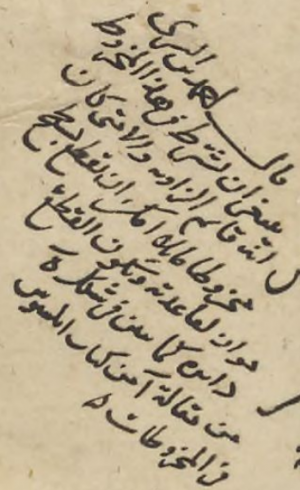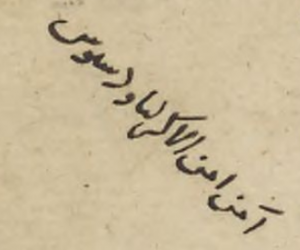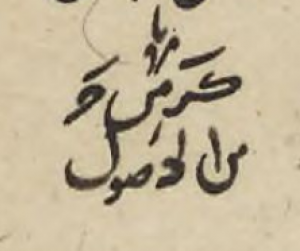About this manuscript
"Middle Books" in the astronomical curriculum
The Kitāb fī'l-ẓāhirāt is a translation of a Greek text, the Phaenomena, which was originally written by the ancient mathematician Euclid. It is one of many Greek scientific works which were translated into Arabic during the translation movement of the 3rd/9th century. It is an astronomical treatise which deals with spherical geometry and the movements of the stars. The text is divided into multiple propositions or figures (shakl), each of which has a mathematical diagram and is numbered with an abjad numeral. Proposition 1 therefore is numbered ʾalif, 2 is bāʾ, 10 is yāʾ, 11 is yāʾ
ʾalif, etc. (for a list of the letter-number values used in Arabic see this table, also Gacek 2009, 11).

The first colophon (on f 99v) notes that this treatise is a translation by ʿĪsā b. Yaḥyā (3rd/9th c) for Abū al-Hasan ʿAlī b. Yaḥya (d. 275/888). According to the second colophon (same folium), this particular manuscript of the Kitāb fī'l-ẓāhirāt is a copy of a copy originally penned by Najm al-Dīn Abū al-Futūḥ Aḥmad b. Muḥammad b. al-Sarī, also known as the mathematician Ibn al-Ṣalāḥ (6th/12th c).
NB The Leiden catalogue accidentally mentions ʿAlī b. Yaḥyā b. ʿĪsā b. Yaḥyā as the translator. Abū al-Ḥasan ʿAlī b. Yaḥya and ʿĪsā b. Yaḥyā, however, are both known figures from the ninth century translation movement. The former served as a patron to various translators and was the recipient of the famous Risāla written by Ḥunayn ibn Isḥāq. The latter worked as a translator: many of his translations are mentioned also in the Risāla (see the recent edition by Lamoreaux). Both individuals are named in other sources, such as in the biobibliographical text The Best Accounts of the Classes of Physicians by Ibn Abī Uṣaybiʿa (see chapters 9.5 and 9.41 in Savage-Smith 2020.)
Kitāb fī'l-ẓāhirāt is the third of three texts contained in the compilation manuscript (majmūʿa) Leiden Or. 1031. The other two texts are also Arabic translations of ancient Greek works on spherical geometry: al-Ṭulūʿ wa'l-Ġurūb (On Risings and Settings by Autolycus) and Kitāb al-Ukar (Sphaerica by Theodosius). All three texts were part of a larger astronomical curriculum that was called the Middle Books (Al-Mutawassiṭāt) because they were the books read between Euclid’s Elements and Ptolemy’s Almagest. The Middle Books most famously existed in an edition (taḥrīr) published by the renowned astronomer Naṣīr al-Dīn al-Ṭūsī (d. 672/1274). The manuscript Leiden Or. 1031, however, preserves witnesses of the text prior to al-Ṭūsī’s edition.
Comments and references
The marginal comments in Leiden Or. 1031/3 offer a mixture of textual corrections, comments from scholars on the text, and references to other texts (here, these are mostly other texts in the Middle Books curriculum).

Marginalia in the first category are marks of corrections, and usually clearly indicated with the abbreviated صح at the end and tend to be quite brief. They appear throughout the manuscript.
More intriguing are notes from the second category. The second colophon claims this manuscript witness was only twice removed from Ibn al-Ṣalāḥ’s own copy; there indeed are marginalia that preserve some of that scholar’s work with the text. The individual who copied these marginal glosses took care to note their origin: see for example the gloss that opens with “قال احمد بن السري” (“Aḥmad b. al-Sarī said...”) on folium 76r (illustrated right). This particular marginal note ends with an independent letter ه hāʾ: such abbreviation is common to signal the end of a gloss - it is an abbreviation for intahā ("it is finished").

A third category of marginalia are formulaic and appear to be motivated by the curriculum in which the Kitāb fī'l-ẓāhirāt was included. An example can be seen on folio 76r: “ا من ا من الاكر لثاودسيوس” (“[proposition] 1 of [book] 1 of the Sphaerica by Theodosius”). These formulaic marginalia indicate situations where a mathematical point used in the main text of Kitāb fī'l-ẓāhirāt was covered elsewhere. The propositions cited in these short glosses all cross-reference other texts from the Middle Books curriculum or the Elements (which preceded it).

Folium 77v offers two more examples of this type of cross-referencing gloss, and in both cases the word ḥāshiyah marks them as marginalia. Folium 88r has another interesting case. The gloss reads “كز من ج من الأصول” (“[proposition] 27 of [book] 3 of the Elements [of Euclid]”), and above it is a reference mark. This reference mark is duplicated in the main text to indicate exactly what part of the text relates to the comment.
Further reading
A. Gacek, Arabic Manuscripts, a Vademecum for Readers. Brill 2009, 114 ff, 156 ff.
J. C. Lamoreaux, Ḥunayn ibn Isḥāq on His Galen Translations. Brigham Young University Press 2016.
E. Savage-Smith et al., A Literary History of Medicine. Leiden 2020.
Questions
-
Leaf through the manuscript of Kitāb fī'l-ẓāhirāt (folios 75v-99v in the viewer frame above) and note which marginal comments cite propositions from other texts. How many texts are cited in this manuscript?
-
There is an insert located between folios 88 and 90 (the foliation is later, and the insert itself evidently was counted as 89). Its presence is explained by a marginal note in the manuscript. Find that note: why was this insert added?
